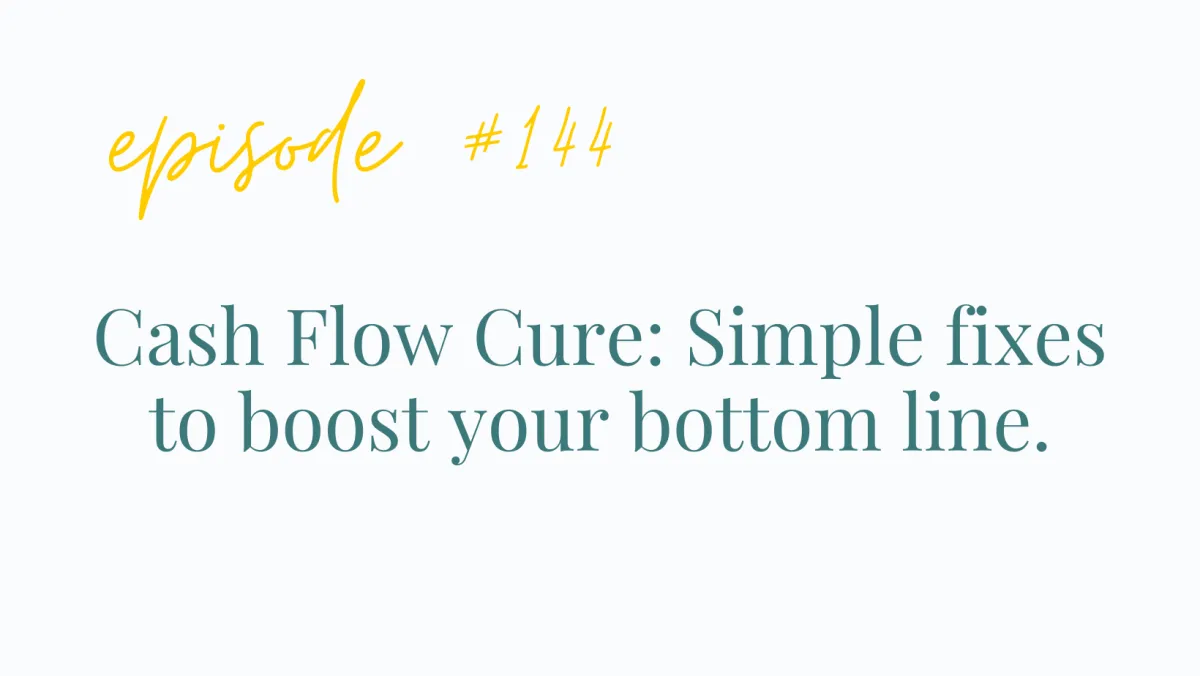
The EffortLESS CEO Podcast
Your weekly dose of actionable strategies for working less and living more.
The EffortLESS CEO Podcast
Your weekly dose of actionable strategies for working less and living more.

Grab your earphones and join me in conversation...

Cash Flow Cure: Simple fixes to boost your bottom line.
👇LISTEN HERE NOW👇
If you’re a business owner, chances are you have experienced the dread, sleepless nights, and 2am panic attacks that inevitably come when we know we need to pay expenses and there isn’t enough cash in the bank to do so.
In the last week I had conversations with over 150 business owners and when I asked them what their biggest pain point in their business is right now, the majority said Cash Flow.
According to statistics cash flow issues are the leading cause of business failure in South Africa, with 70-80% of small businesses failing within the first five years.
In this episode I am sharing a few simple ways to improve cash flow in your business and three habits you must start doing if you want to conquer cash flow challenges once and for all.
Let’s start with what cash flow actually is because many business owners think that fixing cash flow simply means signing more clients. Or generating more revenue. And although increased revenue can improve cash flow, more revenue also often comes with more expenses. Only focusing on increasing revenue won’t help if you don’t understand how cash flows through your business or where it is leaking out faster than you’re bringing it in.
What is Cash Flow?
Cash flow is the flow of money into the business and the flow of money out of the business. In the simplest form it is getting paid and paying expenses.
Our businesses are in a constant cycle of investing cash and receiving cash back…with the aim of making a profit of course.
In order for us to manage our cash flow better and avoid cash crunches as much as possible we need to understand this cycle inside our business. Because for every business the flow will be different.
The Cash Flow Conversion Cycle
The cycle of cash flow in a business typically starts with the cash you have in the bank, you then deploy resources to produce or render services (or products).
Which means that you now have an obligation to pay suppliers and team members. So at this point you have either paid out the cash you have in your bank or you owe vendors and suppliers the money. No one works for free, right.
In order to get cash flowing into the business you need to make a sale. The problem is. We often make the sale and it gets captured in the books but we haven’t actually gotten paid yet. Which means you have accounts receivable. Money owed to you. But the cash will only hit your bank account at some date in the future. This is the basis of the Accrual system in accounting. You capture transactions when they happen, not when cash is received or paid. And only when you receive payment on those accounts will you see the cash back in your bank. Hopefully with more in there than you started out with.
The challenge all business owners face and the solution to your cash flow problems lies in shortening this cycle as much as possible. More specifically, delaying the paying out of cash as much as possible and speeding up the flow of money into the business as much as possible while making as much profit as possible.
Profit does not equal Cash Flow
And this brings us to an important distinction between what you’re seeing on your income statement as profit vs what you actually have in the bank.aka cash flow. Have you ever looked at your income statement and saw a nice juicy profit at the bottom of the page and then felt a surge of confusion (followed by panic) because that profit is not reflecting in your bank account.
This is because there is a fundamental difference between Profit and Cash flow (and because the income statement only tells half the story)
Profit is not the same as Cash Flow.
The Fundamental Difference Between Profit And Cash Flow
Profit is Revenue Minus Expenses.
Cash Flow is about the timing of money flowing in and money flowing out. When you got paid (actual money in) and when you paid an expense (actual money out).
Let’s look at what the cash flow cycle might look like in a business that buys stock and sells it for a profit:
So a business buys stock on January First. That’s when they place the order. They have two weeks to pay the outstanding invoice from their supplier. And they pay on January the 15th.
They’ve received the stock but it sits on their shelf until the 1st of April when it is sold to a client.
The client is on a 60 day account and the business only receives payment in their bank account on the 31st of May.
This means that from date of purchase of the inventory to the sale of the inventory is January 1 – April 1 or 90 days
The number of days from making the sale to actually receiving the cash is April 1 – May 31 or 60 days
The total cash collection cycle in this case was 137 days. With 123 days between paying money out and receiving actual cash back into the business.
They spent their cash on January 15th and didn’t get it back until May 31st. That’s more than a quarter of the year! The problem is, during that time, rent still had to be paid. Employees still had to get their monthly salaries. Water and lights had to be paid. Which typically means the owner needs to finance those bills or expenses while they wait for the cash to come in. Or they need to get financing from a bank or lender…And a lot of owners, never actually get out of that hole.
When it comes to managing cash flow well, your number one focus should be speeding up the inflow of money and delaying the outflow of money as much as possible.
Let’s look at a few ways you can do just that:
Speed Up Cash Inflows
Ask for payment. In other words. Follow up. Do not assume that people got your invoice or payment request. If you send an invoice, give your client a call to confirm they received it. And don’t be afraid to ask for payment when it’s due.
Which brings us to the second point. Stay on top of past due payments. If payments have gone past the due date, don’t just assume that the money is lost. Get into contact with your customer and ask when payment will be made.
Incentivise your clients and customers to pay early. Consider a discount on outstanding payments when they are paid early. As an example. If your clients have a 30 day account, consider a percentage discount if they pay their invoice within the first 10 days.
Ask for deposits before the work begins and invoice progress payments or for milestones reached so that money is coming in more regularly.
As a last resort. Consider getting a collections company to help you collect outstanding debtors. Now, I understand that no one wants to get to this point where they need to bring in a third party. Ideally you want to collect outstanding debtors before it becomes necessary for this. Make sure that you understand the collection process and that the collection company’s values are aligned with yours because when they phone or communicate with your client, they are representing you. And even though nobody likes getting to this point, it is possible to do it in a way that is respectful and professional. These companies take a fee for collecting debt on your behalf, so be sure to understand the costs associated as well.
Slow Down Cash Outflows
Pay your bills as late as possible. Don’t pay invoices simply because you received them. Make sure you understand the terms and when the last day for payment is. If you have seven days. Pay on day 7. If you have 30 days. Pay on day 30.
Where possible, set up 30 or 60 day accounts with your suppliers.
For larger supplier payments, ask if a payment plan is an option.
Instead of buying expensive equipment outright, consider renting or leasing. It might be more expensive in the long run, but it’s always worth considering the cost of not having the cash in your bank.
If your business holds stock. This is one place where we can easily overspend in an attempt to save on delivery fees or price increases.
Lastly, just because you have cash in the bank and bulls are paid doesn’t mean it is cash you can spend. Be very mindful before spending. Always keep your monthly expenses as lean as possible. It’s easy to focus on cutting expenses when cash is tight but it’s even more important to keep expenses to a minimum even when things are going well. Because the months where it rains cash gives you an opportunity to create a buffer of cash for those winter months.
3 Habits To Conquer Cash Flow Problems For Good
Let’s look at the three habits every business owner should focus on (and that most never do) that will improve the cash flow inside your business :
Focus on marketing. You are not just a business owner. You are also a marketer. Most owners are spending the majority of their time doing inside the business and very little or no time marketing the business. You absolutely want to serve your current clients well and focus on ways to get your current clients to spend more because it is cheaper to get an existing client to spend again than it is to get a new customer. That being said. You should also focus on getting new customers or clients for your business.
Build a cash buffer inside your business. Ideally you want a 3 months buffer of expenses saved up. And this is by no means an easy feat. It’s hard to save even one month’s salary or wages. But creating a buffer isn’t something that needs to happen overnight. You can build your way to it. The first shift that needs to happen is your mindset around the money inside your business. Your business’ money isn’t your money. You are a custodian/ a steward of that money. Determine what amount you want to have as a cash buffer inside your business. Like I said, 3 months of expenses is a great goal to have and then start putting away 1% of your revenue into a high yield savings account. And adjust that percentage to 1.5% and then 2% every quarter. Commit to not using that cash buffer. Unless it is a true emergency. Side note. Decide in advance what an emergency is. So that it is clear when you can dig into that reserve and when not.. This is why it is important to have a cash buffer. So that the business can cover expenses and serve clients even on the slow or low income months.
When we know we have cash in the bank for the rainy days it brings a lot of relief.
There are lots of creative ways to manage your cash better but it truly starts with your mindset and understanding the flow of money inside your business.
Understand the numbers on your financial statements. In this case the income statement, the balance sheet, and your cash flow statement. Sit down with your accountant and do a cash flow projection. It isn’t an easy task for all types of businesses but a task you should do regardless. Remember, it is YOUR responsibility to understand the numbers. If there is something you don’t understand. Ask. Do research. Find the answer. It may be super uncomfortable in the beginning but well worth it.
I always suggest to my clients that they have a money date with their business, and their accountant at least once a month to look at and talk about the numbers. Make it your mission to understand the numbers inside your financial statements so that you can ask better questions and make better decisions.
I hope this episode has given you some insight into managing the cash in your business better.
If you found this helpful. Share it with a friend in business and let’s help each other grow.
Did you miss last week's episode? - Catch up HERE
If you found value from the podcast, subscribe so you never miss out on a new episode!
Leave us a positive review here and help us reach and help more business owners.
ilonkaras.com | Ilonka Ras Coaching Pty Ltd
All Rights Reserved


